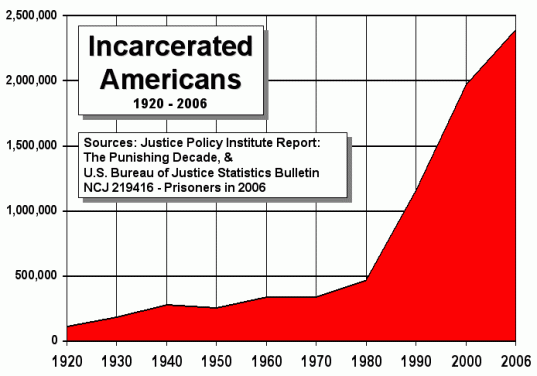How many prisoners are incarcerated in the United States?
- American prisons and jails held 2,424,279 inmates in 2008. (Correctional Population Trends Chart, U.S. Bureau of Justice Statistics.)
- The United States has the highest documented incarceration rate in the world at 754 persons in prison or jail out of every 100,000 (as of 2008). (Prisoners in 2008, U.S. Bureau of Justice Statistics.)
- Approximately 1 in every 18 men in the United States is either behind bars or being monitored.
- 70% of prisoners in the US are non-whites. (Moore, Solomon (March 2, 2009). "Prison Spending Outpaces all but Medicaid". New York Times: p. A13
- Prisons have seen a surge in population since 1980, as a result of new sentences that came about during the "War on Drugs". These criminals arrested for drugs usage are now overcrowding the prison system. ("Drug Arrests by Age 1970-2007". Bureau of Justice Statistics, US department of Justice. Retrieved 2006-12-09.)
- Nearly one million of the inmates in state and federal prisons or local jails are serving time for committing non-violent crimes. ("America's One-Million Nonviolent Prisoners". Center on Juvenile and Criminal Justice. March 1999. Retrieved 2006-06-13.)
- In 2002, 93.2% of prisoners were male.
- A 2005 report shows that an estimated 27% of federal prison inmates are non-citizens, convicted of crimes while in the country legally or illegally. ("GAO-05-337R Information on Criminal Aliens.)
- Costs of maintaining prisoners keeps rising every year. In 2008-2009 California reported it spent $47,000 per inmate to keep them incarcerated. (Legislative Analyst's Office of California).
What is causing the prison system to become overcrowded?
- During the late 80's and early 90's, state and local governments got tougher on crime by passing legislation calling for mandatory sentencing of repeat offenders. An example of these new laws would be California's, "Three strikes law and you're out," law. New York adopted the "Broken Windows," strategy which prosecuted and arrested all crimes large and small.
- These new law have contributed to the overcrowding problem which are forcing prisons to release violent prisoners after only a fraction of their sentences.
- The release tactic that prisons are using has created a "Revolving Door," criminal system with offenders committing the same crimes and being sent right back into the system where they had started.
- 67.5% of criminals released from prison were eventually rearrested for a felony or serious misdemeanor within the next three years.
- In 2005, prisons operated at an average of 134% over capacity.
- Currently parole and probation officers only meet with a criminal on average of 5 to 20 minutes a month.
http://www.lostrepublic.us/Graphics/US_incarceration_timeline-clean.gif

